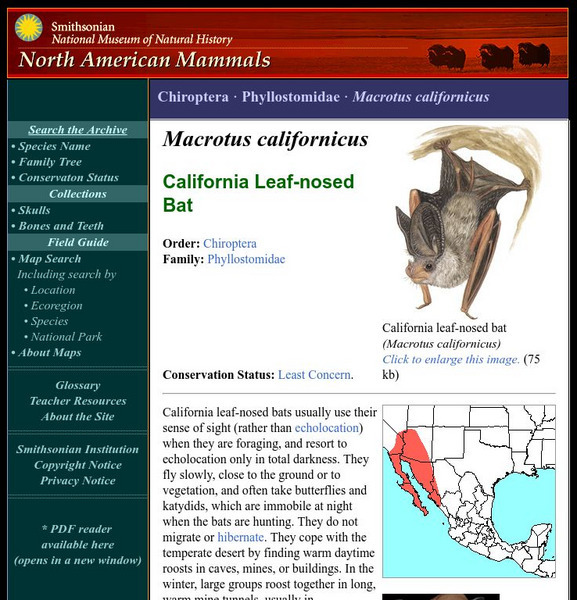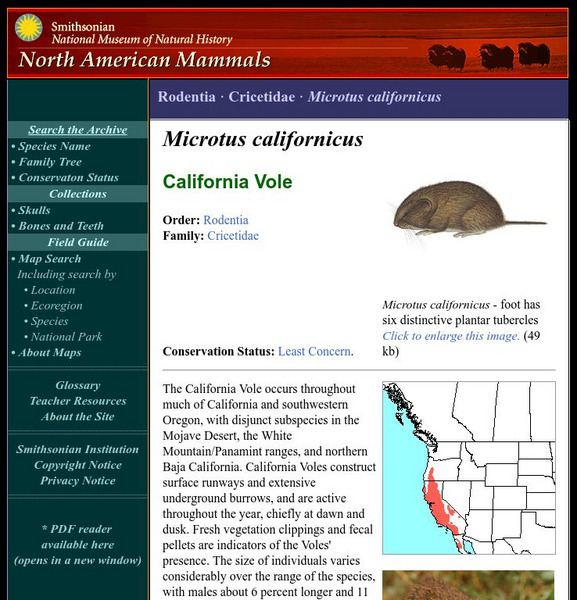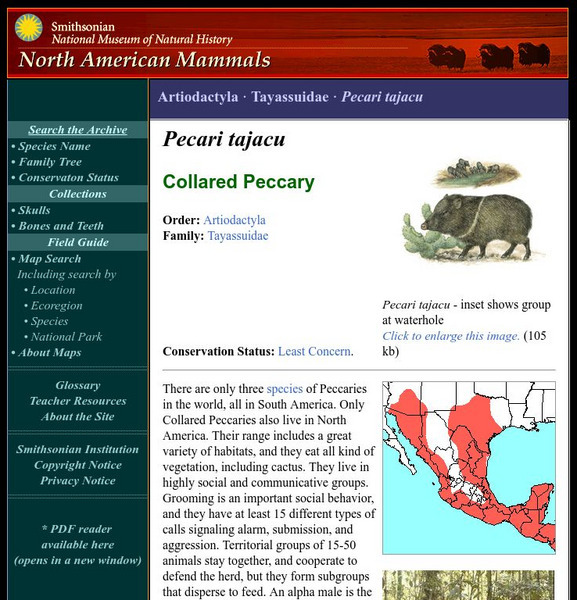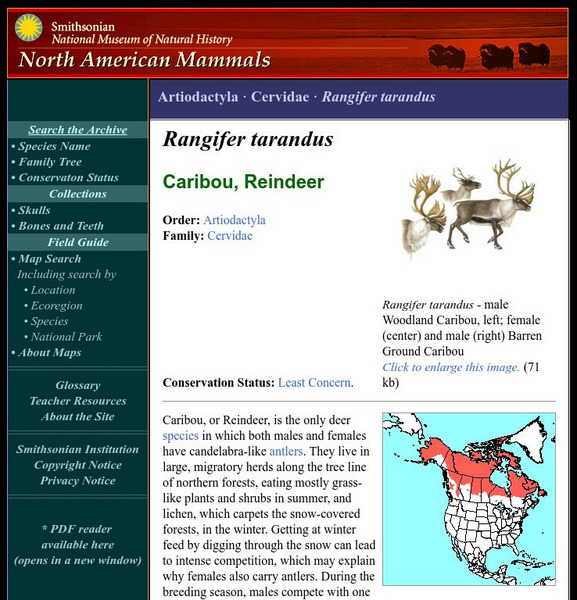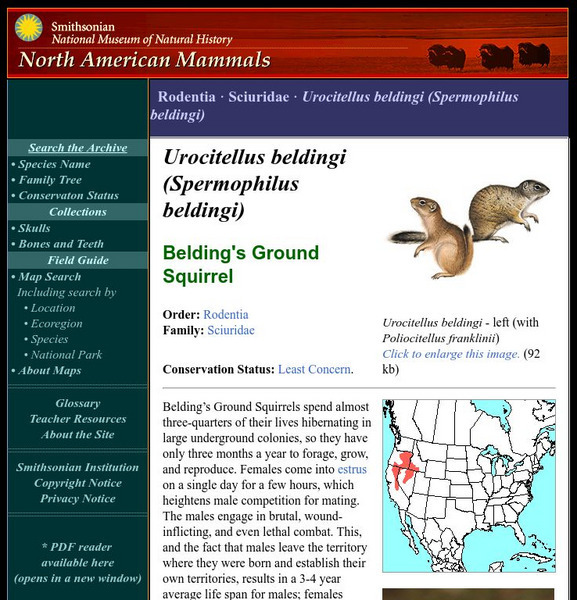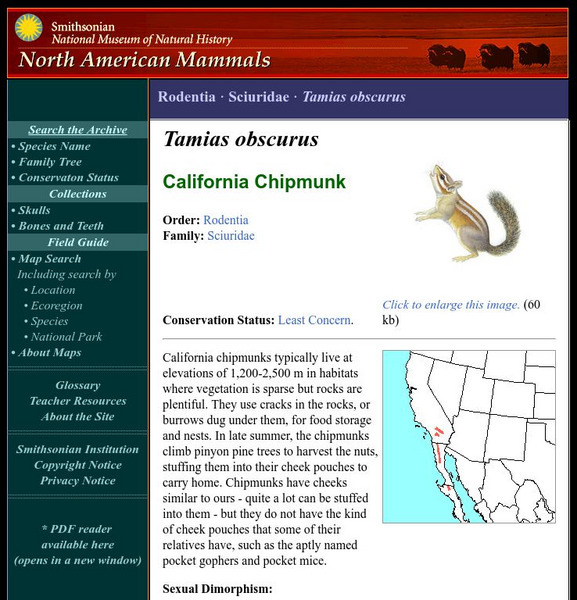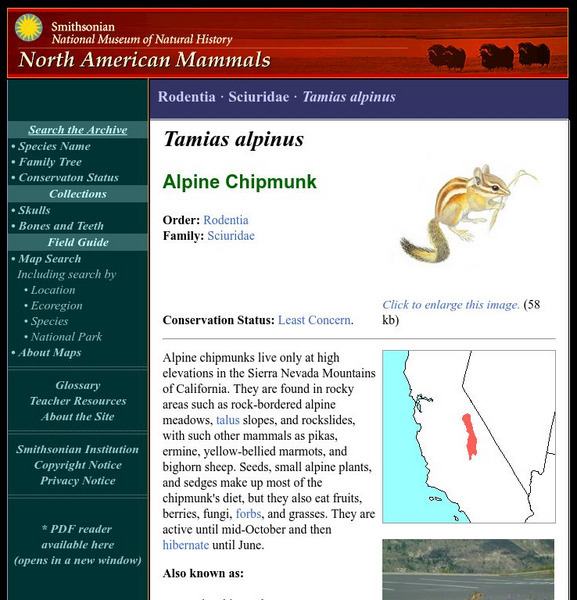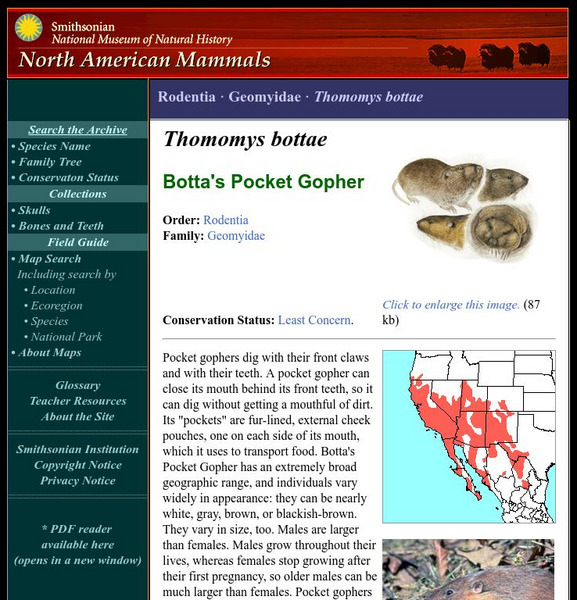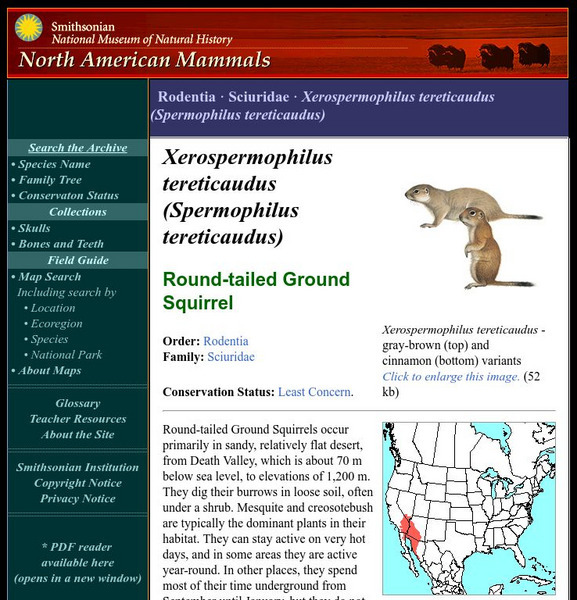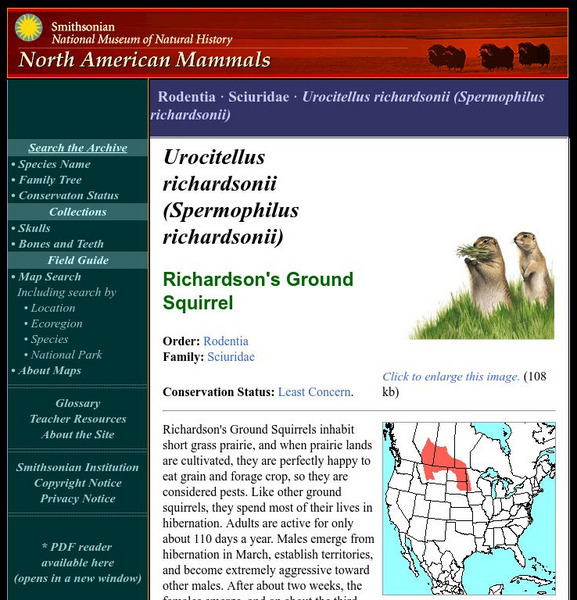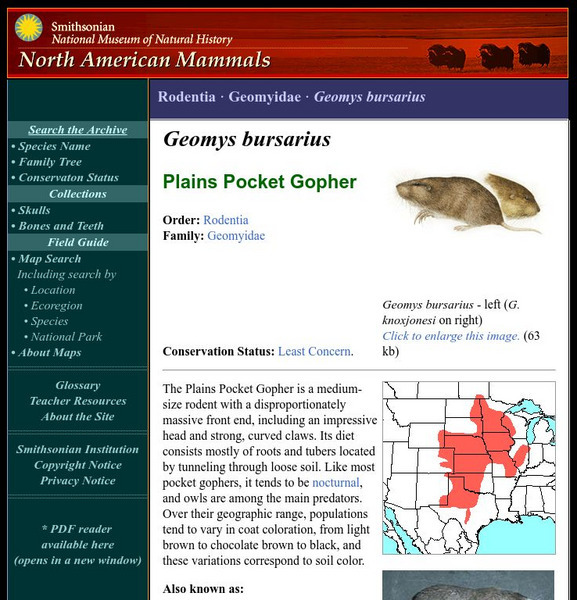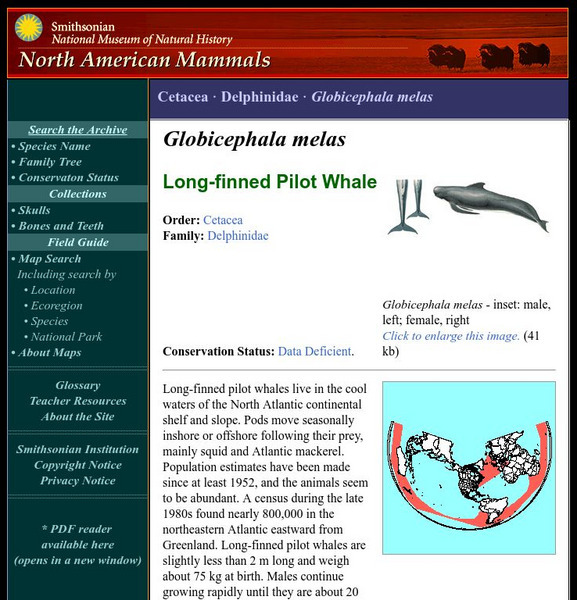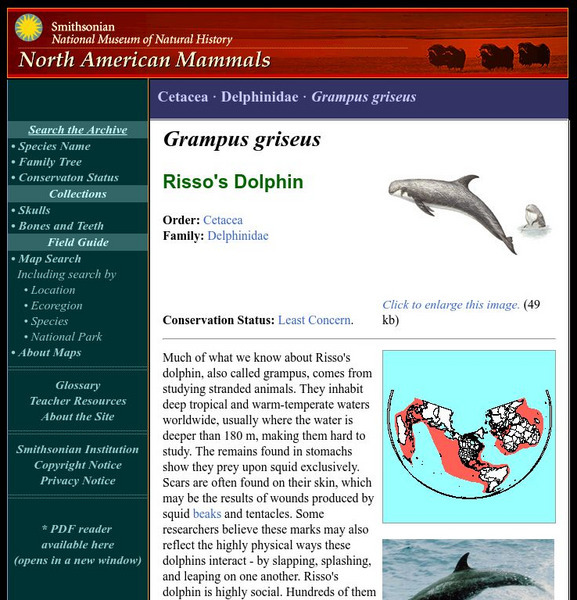Smithsonian Institution
National Museum of Natural History: American Mammals: California Leaf Nosed Bat
California leaf-nosed bats usually use their sense of sight (rather than echolocation) when they are foraging, and resort to echolocation only in total darkness. They fly slowly, close to the ground or to vegetation, and often take...
Smithsonian Institution
National Museum of Natural History: American Mammals: California Vole
The California Vole occurs throughout much of California and southwestern Oregon, with disjunct subspecies in the Mojave Desert, the White Mountain/Panamint ranges, and northern Baja California. California Voles construct surface runways...
Smithsonian Institution
National Museum of Natural History: American Mammals: Beach Vole
Found only on Muskeget Island, the Beach Vole became isolated from its closest relative, the Meadow Vole, about 3,000 years ago during a glacial melt and rise in sea level. It is the only mammal endemic to Massachusetts, the result of...
Smithsonian Institution
National Museum of Natural History: American Mammals: Black Footed Ferret
Once widespread in the grasslands and western basins of North America, by 1987 Black-footed Ferrets were thought to be extinct in the wild. Captive animals were bred in an effort to save the species, and in 1991, some were reintroduced...
Smithsonian Institution
National Museum of Natural History: American Mammals: Collared Peccary
There are only three species of Peccaries in the world, all in South America. Only Collared Peccaries also live in North America. Learn more about the Pecari tajacu, more commonly known as a Collared Peccary, in this easy-to-read species...
Smithsonian Institution
National Museum of Natural History: American Mammals: Caribou
Caribou, or Reindeer, is the only deer species in which both males and females have candelabra-like antlers. They live in large, migratory herds along the tree line of northern forests, eating mostly grass-like plants and shrubs in...
Smithsonian Institution
National Museum of Natural History: American Mammals: Belding's Ground Squirrel
Belding's Ground Squirrels spend almost three-quarters of their lives hibernating in large underground colonies, so they have only three months a year to forage, grow, and reproduce. Females come into estrus on a single day for a few...
Smithsonian Institution
National Museum of Natural History: American Mammals: California Ground Squirrel
California Ground Squirrels prefer open, well-drained habitat, and are common along roadsides, on farms, especially where grain is grown, and in grassy fields. Adult squirrels are active only a few months of the year. Learn more about...
Smithsonian Institution
National Museum of Natural History: American Mammals: Clymene Dolphin
The Clymene dolphin is distinguished from the very similar spinner dolphin by the shortness of its beak and its color pattern. Like spinners, they "spin," leaping high out the water and rotating (not a somersault, but a sideways roll)...
Smithsonian Institution
National Museum of Natural History: American Mammals: Atlantic Spotted Dolphin
The Atlantic spotted dolphin is seen in coastal waters from the Carolinas south to Brazil, usually staying within about 350 km of the coast. Another population is known from the Gulf Stream near New England. Learn more about the Stenella...
Smithsonian Institution
National Museum of Natural History: American Mammals: Allen's Chipmunk
Allen's chipmunks live in mature forests and spend a lot of their time in the trees, but search for food on the forest floor. Females are larger than males, and the chipmunks that live in coastal redwood forests are larger than the ones...
Smithsonian Institution
National Museum of Natural History: American Mammals: California Chipmunk
California chipmunks typically live at elevations of 1,200-2,500 m in habitats where vegetation is sparse but rocks are plentiful. They use cracks in the rocks, or burrows dug under them, for food storage and nests. Learn more about the...
Smithsonian Institution
National Museum of Natural History: American Mammals: Alpine Chipmunk
Alpine chipmunks live only at high elevations in the Sierra Nevada Mountains of California. They are found in rocky areas such as rock-bordered alpine meadows, talus slopes, and rockslides, with such other mammals as pikas, ermine,...
Smithsonian Institution
National Museum of Natural History: American Mammals: Botta's Pocket Gopher
Pocket gophers dig with their front claws and with their teeth. A pocket gopher can close its mouth behind its front teeth, so it can dig without getting a mouthful of dirt. Learn more about the Thomomys bottae, more commonly known as a...
Smithsonian Institution
National Museum of Natural History: American Mammals: Black Tailed Prairie Dog
Black-tailed prairie dogs exhibit the most complex social behavior of all prairie dogs. Social groups called "coteries" live together in very large colonies called "towns. Learn more about the Cynomys ludovicianus, more commonly known as...
Smithsonian Institution
National Museum of Natural History: American Mammals: Atlantic White Sided Dolphin
Like other species of the genus Lagenorhynchus, the Atlantic white-sided dolphin is a stocky animal with a short, thick snout. It is common in cold North Atlantic waters. Learn more about the Lagenorhynchus acutus, more commonly known as...
Smithsonian Institution
National Museum of Natural History: American Mammals: Alaskan Hare
Female Alaskan Hares nurse their young for an extended period, providing them with enough nutrition to grow extraordinarily quickly during the short Alaskan summer. There is an average of six furry little hares in a litter, and females...
Smithsonian Institution
National Museum of Natural History: American Mammals: Ginkgo Toothed Beaked Whale
Almost nothing is known of the ginkgo-toothed beaked whale. Nothing about its behavior or feeding habits has been reported, and its geographical distribution is estimated from a very small sample. Learn more about the Mesoplodon...
Smithsonian Institution
National Museum of Natural History: American Mammals: Round Tailed Ground Squirrel
Round-tailed Ground Squirrels occur primarily in sandy, relatively flat desert, from Death Valley, which is about 70 m below sea level, to elevations of 1,200 m. They dig their burrows in loose soil, often under a shrub. Learn more about...
Smithsonian Institution
National Museum of Natural History: American Mammals: Golden Mantled Ground Squirrel
Restricted to the Cascade Mountains of Washington State and British Columbia, Cascade golden-mantled Ground Squirrels are so similar to golden-mantled Ground Squirrels that some scientists consider them the same species. However, their...
Smithsonian Institution
National Museum of Natural History: American Mammals: Richardson's Ground Squirrel
Richardson's Ground Squirrels inhabit short grass prairie, and when prairie lands are cultivated, they are perfectly happy to eat grain and forage crop, so they are considered pests. Like other ground squirrels, they spend most of their...
Smithsonian Institution
National Museum of Natural History: American Mammals: Plains Pocket Gopher
The Plains Pocket Gopher is a medium-size rodent with a disproportionately massive front end, including an impressive head and strong, curved claws. Its diet consists mostly of roots and tubers located by tunneling through loose soil....
Smithsonian Institution
National Museum of Natural History: American Mammals: Long Finned Pilot Whale
Long-finned pilot whales live in the cool waters of the North Atlantic continental shelf and slope. Pods move seasonally inshore or offshore following their prey, mainly squid and Atlantic mackerel. Learn more about the Globicephala...
Smithsonian Institution
National Museum of Natural History: American Mammals: Risso's Dolphin
Much of what we know about Risso's dolphin, also called grampus, comes from studying stranded animals. They inhabit deep tropical and warm-temperate waters worldwide, usually where the water is deeper than 180 m, making them hard to...
